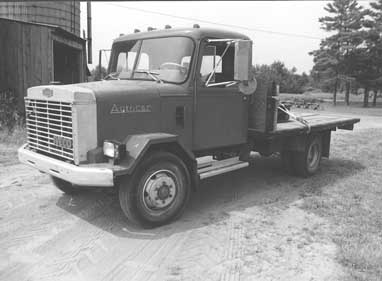"It's a heavy-built 1 1/2-ton truck that has cost me very little over the years," says Victor Larson, Freesoil, Mich., about his 1984 Iveco cab-over truck which he "restored" by replacing the truck's original cab, which had rusted out, with one off a used Autocar truck. Larson bought the Iveco truck used and mounted a home-built flatbed on it. When the cab rusted out, he found a 1979 Autocar cab off a dump truck. The cab was longer than the Iveco cab so he removed the original truck frame and replaced it with a longer one off another used Iveco truck. He made a new front end, and also made a new hood, fenders, grille, muffler, and installed a set of headlights designed for snowplows. He also replaced the truck's original hydraulic brakes with air brakes. The truck still has its original engine, 5-speed transmission, drive train, chassis, and wheels. "It has way more than 200,000 miles on it so it doesn't owe me a nickle," says Larson. "I use it to haul grain, wheat seed, hay, shelled corn, equipment, pallets of wood, etc. It has 'armstrong' power steering and isn't a fancy truck, but it always gets me home. It can haul five to six tons at a time. I made my own grain box that mounts on the flatbed. The flatbed is equipped with a fifth wheel hitch for pulling trailers and has a receiver hitch on back. "The Iveco cab-over truck is made in Italy while the Autocar is a division of White trucks and is made in the U.S. Autocar trucks are still made today and are now part of the Volvo-White company. Autocar trucks are built tough. There's a saying that goes, 'All other trucks wear out, but Autocars just grow old'. I bought the Autocar cab at a scrap yard. "Although the Iveco cab was rusted out the chassis was still good. Altogether I used parts off three different Iveco trucks to rebuild this model." 
1-800-834-9665
Replacement Cab Kept Old Truck On The Road
FARM SHOW Magazine » Replacement Cab Kept Old Truck On The Road
Replacement Cab Kept Old Truck On The Road
